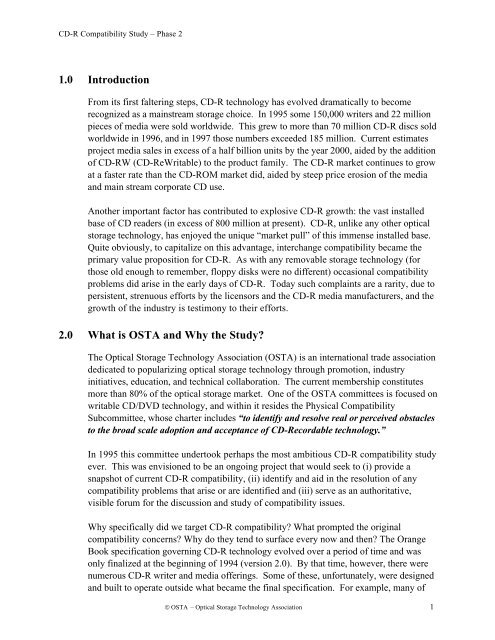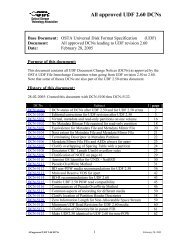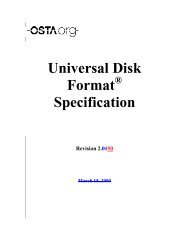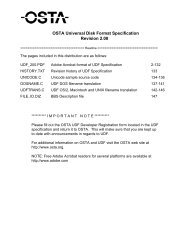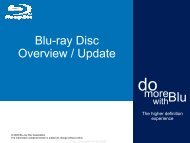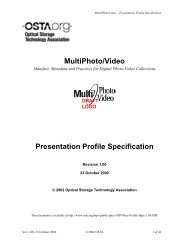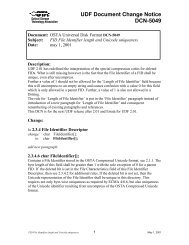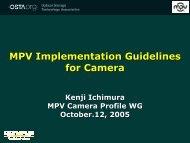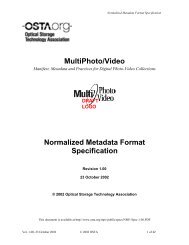osta cd-r compatibility study results from phase 2 - OSTA - Optical ...
osta cd-r compatibility study results from phase 2 - OSTA - Optical ...
osta cd-r compatibility study results from phase 2 - OSTA - Optical ...
You also want an ePaper? Increase the reach of your titles
YUMPU automatically turns print PDFs into web optimized ePapers that Google loves.
CD-R Compatibility Study – Phase 2<br />
1.0 Introduction<br />
From its first faltering steps, CD-R technology has evolved dramatically to become<br />
recognized as a mainstream storage choice. In 1995 some 150,000 writers and 22 million<br />
pieces of media were sold worldwide. This grew to more than 70 million CD-R discs sold<br />
worldwide in 1996, and in 1997 those numbers exceeded 185 million. Current estimates<br />
project media sales in excess of a half billion units by the year 2000, aided by the addition<br />
of CD-RW (CD-ReWritable) to the product family. The CD-R market continues to grow<br />
at a faster rate than the CD-ROM market did, aided by steep price erosion of the media<br />
and main stream corporate CD use.<br />
Another important factor has contributed to explosive CD-R growth: the vast installed<br />
base of CD readers (in excess of 800 million at present). CD-R, unlike any other optical<br />
storage technology, has enjoyed the unique “market pull” of this immense installed base.<br />
Quite obviously, to capitalize on this advantage, interchange <strong>compatibility</strong> became the<br />
primary value proposition for CD-R. As with any removable storage technology (for<br />
those old enough to remember, floppy disks were no different) occasional <strong>compatibility</strong><br />
problems did arise in the early days of CD-R. Today such complaints are a rarity, due to<br />
persistent, strenuous efforts by the licensors and the CD-R media manufacturers, and the<br />
growth of the industry is testimony to their efforts.<br />
2.0 What is <strong>OSTA</strong> and Why the Study?<br />
The <strong>Optical</strong> Storage Technology Association (<strong>OSTA</strong>) is an international trade association<br />
dedicated to popularizing optical storage technology through promotion, industry<br />
initiatives, education, and technical collaboration. The current membership constitutes<br />
more than 80% of the optical storage market. One of the <strong>OSTA</strong> committees is focused on<br />
writable CD/DVD technology, and within it resides the Physical Compatibility<br />
Subcommittee, whose charter includes “to identify and resolve real or perceived obstacles<br />
to the broad scale adoption and acceptance of CD-Recordable technology.”<br />
In 1995 this committee undertook perhaps the most ambitious CD-R <strong>compatibility</strong> <strong>study</strong><br />
ever. This was envisioned to be an ongoing project that would seek to (i) provide a<br />
snapshot of current CD-R <strong>compatibility</strong>, (ii) identify and aid in the resolution of any<br />
<strong>compatibility</strong> problems that arise or are identified and (iii) serve as an authoritative,<br />
visible forum for the discussion and <strong>study</strong> of <strong>compatibility</strong> issues.<br />
Why specifically did we target CD-R <strong>compatibility</strong>? What prompted the original<br />
<strong>compatibility</strong> concerns? Why do they tend to surface every now and then? The Orange<br />
Book specification governing CD-R technology evolved over a period of time and was<br />
only finalized at the beginning of 1994 (version 2.0). By that time, however, there were<br />
numerous CD-R writer and media offerings. Some of these, unfortunately, were designed<br />
and built to operate outside what became the final specification. For example, many of<br />
© <strong>OSTA</strong> – <strong>Optical</strong> Storage Technology Association 1


